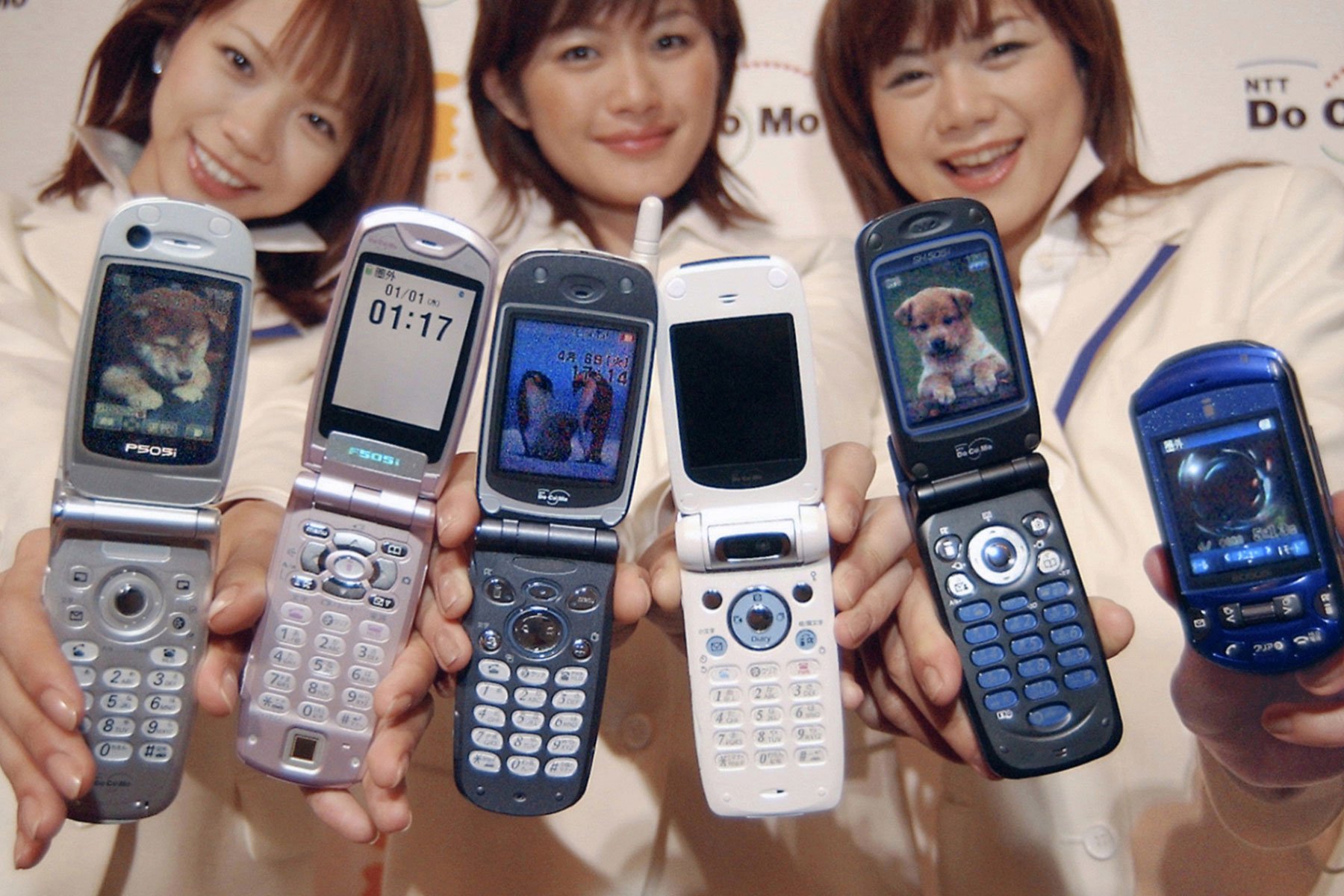The Mysteries of Japan-Only Phones

Once upon a time, before the common practice of automatically checking one’s phone directly after waking up, There was a simpler time, when cell phones were brick like shapes on their first steps into evolving into the palm-sized computers we have today.
From the 1980s into the New Millennium, Japan was at the forefront of Cellular Technology, dreaming up cell phone designs inspired from anything from purses to cars, with features that would only be matched in Western markets years later. Welcome to the world of Japanese cellular phones, better known to some as the ‘Galapagos phone’ or ‘Garakei’
But first, a little background into what a Galapagos/Garakei phone even is. The Garakei [ガラケー] which is derived from ガラパゴス携帯電話, Garapagosu Keitai Denwa - Galapagos Cell Phone, aptly referring to the cell phones produced in Japan from the 1990s until the peak of the smartphone era in the early 2010’s.
‘Galapagos’ being in reference to the Galapagos Islands, a series of extremely isolated islands off the coast of Ecuador, that make it world famous for having unique animals and plants not found elsewhere in the world due to its separation from other areas. In the same way, Japan’s isolation from other countries sometimes both culturally and even product wise [with many companies making goods for exclusive use in Japan] has led to some pretty bizarre technological creations that have features/designs that wouldn’t necessarily be practical abroad. [Such being that there’s even a term; “Galapagos Syndrome” taught in Japanese business schools that use the exact phenomenon as a topic for case studies]
AU KDDI’s Talby (2004)
Before the rest of the world even managed to get close to basic 2G connection, Japan was already enjoying the joys of surfing the internet through their cell phones, texting via e-mail, and even using their phones to make contactless purchases. Overseas, these cutting-edge advancements were icons of innovation – another form of soft power for Japan.
Docomo Sharp SH-06A x Evangelion Nerv Edition
Yayoi Kusama x AU model [2000s]
The Early Years
Nonetheless, to properly assess the current climate of the Japanese phone market, the narrative needs to start a few decades prior with a throwback to the 70s.
Japan’s own foray into cellular technology began on December 3rd, 1979, when the commercial introduction of cellular technology paved the way for gradual widespread adoption of mobile telephones in a more economically feasible manner. Car phones began to be offered to consumers worldwide within the same year.
“A Telephone is always on the shoulder of a busy man.” NTT’s Shoulder Phone [1987]
Enjoying a shoulder phone on a leisurely stroll [1988]
Six years later, in 1985, the Nippon Telegraph and Telephone Corporation [NTT] released the very first “Shoulder Phone”, a portable mobile phone that is regarded as the very first ‘portable phone’ in Japan. Originally released as an advanced model of a car phone, the device itself weighed a whopping 3kg and most notably, had an ability to be ‘ejected’ from the slot of the car and slung over one’s shoulder to be used while away from your vehicle [just because your drive came to an end, your conversation wouldn’t have to suffer the same fate.]
A Promotional video for telephone communication services in your car, 1987, featuring the sophisticated speaker-phone capability, number storage capabilities and even the appearance of a shoulder phone, all available for the price of ¥280,000- or - ¥346,465 [$2395 USD] today. The end of the video also announces plans to ‘expand’ further network coverage across the country as well as introducing cordless models
NTT’s Portable Phone model [1980s]
NTT’s Portable Phone model [1980s]
NTT Docomo’s Portable Cell Phone [1987]
1987 saw the launch of NTT’s handheld mobile telephone in response to the needs and expectations of innumerable users. The concept of “take and walk” mobile services then began. This was also the starting point for the fast paced race for technological innovation with various rival companies that, one by one, flocked to put their own influence and presence into the telephone market.
Commemorating the launch of NTT Docomo, Featuring the legendary Japanese band “Southern All Stars” (1992)
After a reorganization in 1992, NTT Mobile Communications Network, Inc (Now better known as NTT Docomo) was born and took over the firm’s mobile business.
Prior to the introduction of cell phones, Docomo rolled out the Pocket Bell [named for the size being able to fit in a shirt pocket], a pager device that allowed people to send primitive messages to one another using numbers. In the mid 1980s, the ‘pokeberu’ was a huge hit and everyone from salarymen to school kids were furiously messaging each other. This exact movement was what led to the birth of texting and mobile communications in Japan.
NTT Docomo’s Pocket Bell [1995]
In the mid-late 1980s, mobile phones for the time were bulky, expensive, heavy and quite limited in terms of mobility. Not to mention the lackluster battery life wasn’t ideal for all day usage. In contrast, the pocket bell pagers were small, inexpensive, and were pocketable. Originally marketed towards businesses, young consumers snapped them up and usage spread rapidly over the next decade. By 1991, there were over 5.75 million pager subscribers in the entire nation.
As a precursor to modern day social media, users began referring to people on their contacts as ‘Berutomo’ [Bell friends] Lines would often form outside of public telephone booths where keypads were used to text each other lengthy strings of numbers.
Need to tell your date that you’re running late? 0906. [o ku re te ru – I’m running late]
Or..Checking in with your friends on a Saturday? 724106. [Na ni shi te ru – What are you up to?]
Sending your gratitude for that favor your classmate owed you? 999! [Sankyu!]
Ryoko Hirosue [1996]
A popular idol of the mid-1990s, her very first commercial was to promote the Docomo Pokebell, the narrative by the young teenager being, “I got a Pocket Bell for my birthday, I’m super super happy…and now.. I wonder who I’ll give my Bell number out to”
Further commercials for the Docomo Pokebell Pager [1993]
Pokebell Pager commercial featuring Riona Hazuki [1996]
It might seem ridiculously primitive by today’s standards, but texting your Berutomo would foster friendships that appealed in a completely different way. Some people even had Berutomo that they had never met and who’s pager number they knew, but not their actual names. Not too unlike how Instagram and Twitter run in today’s highly connected age.
By 1996, the pager craze had peaked at 10.6 million subscribers and then sharply dropped as mobile phone users exploded. The last service provider to offer paging services shut down their radio signals and completely terminated their services in October, 2019.
Pagers, Pocket Bells, and Personal handsets
A young woman and her PHS [1990s]
The early technology that helped kick-start the mobile phone wave was the Personal-Handy-Phone System [PHS] Offering the most basic cellular services, low charges and better quality sound compared to that of the bulky brick-like phones that had dominated the market.
With the youth catching on to the practicality, NTT launched their own PHS service in 1995 and in just two short years, saw subscribers peak at 2.12 million users.
A display in Akihabara [1990s]
The PHS ended up becoming overshadowed by the more functional phones that were gradually offered by the top carriers, NTT Docomo, J-Phone, and KDDI. Deregulations in the industry in 1994 allowed for companies to sell mobile phones instead of offering them for rent, triggering an explosion in mobile subscribers. As more people signed up for mobile plans, companies had to stay competitive, competition that fueled intense and rapid innovation.
Advancements would continue to progress to even further heights, when NTT Docomo unveiled a new feature that would put mobile phone evolution into a new era:
Internet Connectivity.
The teaser launch of Docomo’s “i-mode” service [1999]
Docomo’s Poster Girl, Hirosue Ryoko in various advertisements for i-mode
By 1997, Docomo had mainly been targeting younger businessmen and working adults with their phones, Docomo’s then-general Manager, Keiichi Enoki, had been observing his own children using pokeberu’s and PHS phones seamlessly, and argued that personal phones which were capable of sending email and connecting to the internet could prove to be a hit with the general public, but especially to younger users.
That sentiment was also felt by Takeshi Natsuno, a young entrepreneur that had been hired by Docomo to develop and perfect the upcoming service. Natsuno saw mobile phones as a new medium for distributing data and advertising, something that could even be used to make reservations at a popular restaurant and even book tickets for your upcoming flight.
But what would this new service come to be known as? Among the proposed names of MOGI [mobile gear interactive] Kokomo and Monet; Developers Mari Matsunaga and Shigetaka Kurita [more on him later] settled on ‘i-mode’, with the ‘i’ standing for the first person pronoun, as well as “interactive,” “information,” and of course, “internet”
Fujitsu’s F501i HYPER, the first cellphone complete with the i-mode feature [1999]
At the forefront of internet technology, its launch in February 1999 marked the first time mobile phone users could browse web pages and send email. Fujitsu’s F501i HYPER marked this by implementing a circular “i” button above the keypad, the first phone with the program implemented, metaphorically serving as a brand new portal to an exciting digital frontier.
The Birth of the Emoji
In November 1997, J-phone [now better known as Softbank] unveiled the Pioneer DP-211SW. An unusual phone that included a face with no buttons, but only a liquid crystal touch screen. Incredibly innovative as it not only had the ability to display detailed kanji characters, but it also included the world’s first ever feature of displaying emojis.
J-Phone’s Pioneer DP-211SW
J-Phone’s DP-211SW [1997] Featuring the very first iteration of an emoji in the shape of a sprouting whale
Promotional images for the DP-211SW featured a text message that was punctuated with a tiny sprouting whale, the very first emoji to ever appear on a phone screen. These exact emoji designs are also thought to have heavily influenced Apple’s original emoji’s which were designed to be compatible with this exact set, due to the iPhone being a Softbank-exclusive phone when it first went on sale in Japan.
The world’s first glimpse at emoji’s - from the DP-211SW [1997]
While being the first to implement an emoji function, the widespread usage of emojis in the mainstream really took off with the launch of i-mode. Designed by Shigetaka Kurita The service had only allowed for 250 characters which gave Kurita the challenge to figure out a way of communicating in an expressive but brief manner.
“I knew from my experience that with pagers that exchanging short messages over digital devices creates discrepancies in communication, I imagined what it would be like if you could add emotion and nuance to messages as well as decorations to express one’s individuality. Through messaging, communication would be fun.”
Shigetaka Kurita and his emoji’s now part of the permanent collection at the Museum of Modern Art in New York City.
Into the New Millennium – the Garakei
With web browsing, choices in Java applications available to download and emoji enabled messaging, and commercials featuring actress Ryoko Hirosue, i-mode was met with increased public zeal, and in just a year, saw sales topping over 5 million units. Soon after each carrier would launch their own versions of an internet network, KDDI introduced EZWeb, and Vodafone [formerly known as J-Phone] had J-Sky [later changed to Softbank Mobile]
A range of Japanese cell phone commercials from the 2000s
One other invention that Japan had managed to be at the forefront of: the camera phone. Kyocera had released the Visual Phone VP-210 in 1999, a new personal phone that included a built-in camera with a 2-inch color LCD screen. J-Phone, the following year, through Sharp launched their edition of the invention; the J-SH04, which featured a 0.11 megapixel camera and the innovative ability to send photos electronically via the carrier’s 写メール “Sha-meru” [photo mail] service. ‘Sha-me’ photos became wildly popular, and slowly were introduced to the west just two years later.
A young girl strikes a pose [2000s]
Other impressive features included contactless NFC payments [2004] Digital television streaming [2005] Music streaming services, high quality video and camera features, GPS and email based services [just to name a few]
A commercial advertising ‘Osaifu Keitai’ [wallet phone] - An innovative technology allowing the consumer to make purchases with their phone [2004]
A woman using the ‘Osaifu-Keitai’ function to make a purchase [2004]
Even with all this incredibly innovative technology, the question begs, why didn’t companies aim to introduce most of this innovative technology overseas? Unfortunately, Japanese makers were much too focused on its own marketplace, citing it as large and relatively diverse enough, but not to the point that they felt the need to invest in overseas markets. As long as Japan had exponential economic growth that relied exclusively on domestic demand, it was seen as acceptable to focus exclusively on just the Japanese market.
Some had also pointed to the joint relationship between carriers and phone manufacturers: traditionally, carriers would sell handsets that were bought from manufacturers as their own products and would handle all the marketing themselves. This meant that the makers themselves didn’t have to worry about maintaining stocks or promoting their own products entirely on their own.
Au KDDI’s infobar, part of their au design project series [2003]
A limited collaboration with Nicola, a popular magazine for young girls [2000s]
Internationally, i-Mode had been marketed in 17 other countries, but international cell-phones faced hardware issues. Unlike the perception of feature phones internationally, the market in Japan was that each phone was designed from scratch for a much more bespoke experience, which also meant that the exact same phone couldn’t be sold both domestically and internationally. While the phones were crucial for emphasizing a more personal and seamless experience day to day in Japan, outside of the country, they were just mere paper weights, utterly useless.
As the touchscreen revolution proceeded on from 2007, with the birth and introduction of Apple’s iPhone, which was introduced to the Japanese market in 2008, through Softbank.
Japanese iphone commercial from Apple (2008)
Softbank iPhone commercial, featuring the famed “White Family” characters [2008]
Flip phones have mostly been phased out in all parts of the world – except in Japan. NTT lost over $10 billion on it’s failed strategies overseas, but still sustained two thirds of the Japanese market, with around 50 million i-mode users at its peak in 2008. Stubbornly refusing to sell the iPhone until 2013, which resulted in over 20% over the market share being lost to rivals like Softbank.
However, while there is a sense of ridicule for those that stubbornly refuse to adapt to smart-phone usage, there are also practical reasons for why someone would rather use one. Similar to how Nokia phones are renowned for their durability and lengthy battery life in the west, Garakei’s are known to have a much longer battery-span and are more resistant to breaking from drops [unlike their ‘smarter’ successors] Monthly fees are known to be much more budget friendly due to their limited capabilities. Generally, they would be seen as phones that someone would purchase for children or the elderly. Keeping usage simple and straight to the point, without all the bells and whistles of a smartphone.
With plenty of technology in recent times, it might also come as a surprise that a rising amount of members of Generation Z, younger users, namely teenagers, are opting for the primary usage of a more minimal experience with cell phones, for the sake of minimizing their social media usage and prioritizing their own mental health and well-being.
It's hard to dispute that the Garakei that were widespread in the first decade of the 21st century would absolutely surpass the advanced technology that we have today. When thinking back, it all seems primitive and dated compared to what might be on offer from the iOS store or from Android’s constant flurry of advancements.
Yet, unlike modern devices, these older feature phones were given a free pass to be unusual, eccentric, experimental, and a little bit bulky. Suddenly, the glass slab that makers introduce year after year just feels very. Bland. There’s only so much customization one can do with a phone case, or an awkwardly placed strap on said case. Perhaps someday, in the not too far off future, the pendulum might swing in the other direction and cell-phones might become somewhat exciting again.
About the Author:
Stefania Lehman
Born in Beijing and living in Tokyo, Stefania is a creative and a writer for Sabukaru Online. Never leaving home without a camera, she enjoys exploring all different corners Tokyo and Japan have to offer.





